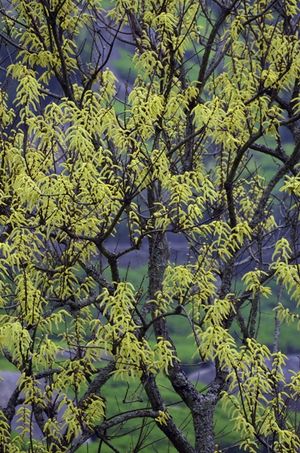Note: This is a project under development. The articles on this wiki are just being initiated and broadly incomplete. You can Help creating new pages.
Salix tetrasperma - Jalavetasa
Jalavetasa is a medium-sized tree of wet and swampy places, shedding its leaves at the end of monsoon season. It flowers after leafing. The bark is rough, with deep, vertical fissures and the young shoots leaves are silky.
Contents
[hide]- 1 Uses
- 2 Parts Used
- 3 Chemical Composition
- 4 Common names
- 5 Properties
- 6 Habit
- 7 Identification
- 8 List of Ayurvedic medicine in which the herb is used
- 9 Where to get the saplings
- 10 Mode of Propagation
- 11 How to plant/cultivate
- 12 Commonly seen growing in areas
- 13 Photo Gallery
- 14 References
- 15 External Links
Uses
Headache, Piles, Astringent, Febrifuge, Cardioprotective, Bradycardia, Influenza, Sinus Infection, Cough
Parts Used
Chemical Composition
vitamins A, B1, B2, C, E, Mg, P, Ca, Fe, and folic acid. Other primary chemical constituents of Asparagus are essential oils, asparagine, arginine, tyrosine, flavonoids (kaempferol, quercetin, and rutin), resin, and tannin.[1]
Common names
| Language | Common name |
|---|---|
| Kannada | Niranji |
| Hindi | Bod, Bains |
| Malayalam | Arali, Atrupala |
| Tamil | Atrupalai |
| Telugu | etipaala |
| Marathi | NA |
| Gujarathi | NA |
| Punjabi | NA |
| Kashmiri | NA |
| Sanskrit | Jalavetasa, Naadeya |
| English | Sallow, Goat Willow |
Properties
Reference: Dravya - Substance, Rasa - Taste, Guna - Qualities, Veerya - Potency, Vipaka - Post-digesion effect, Karma - Pharmacological activity, Prabhava - Therepeutics.
Dravya
Rasa
Tikta (Bitter), Kashaya (Astringent)
Guna
Laghu (Light), Ruksha (Dry), Tikshna (Sharp)
Veerya
Ushna (Hot)
Vipaka
Katu (Pungent)
Karma
Kapha, Vata
Prabhava
Habit
Identification
Leaf
| Kind | Shape | Feature |
|---|---|---|
| Simple | Alternate | The leaves are stipules lateral, ovate, cauducous; petiole 10-25 mm, slender, glabrous, grooved above |
Flower
| Type | Size | Color and composition | Stamen | More information |
|---|---|---|---|---|
| Unisexual | 6 cm long | Yellow | 5-12 | Flowers Season is June - August and Flowers are like bracts ovate, 2 x 2 mm, densely woolly, perianth absent |
Fruit
| Type | Size | Mass | Appearance | Seeds | More information |
|---|---|---|---|---|---|
| Capsule | 4 mm | Clearly grooved lengthwise, Lowest hooked hairs aligned towards crown | With long deciduous hairs | 1-4 | {{{6}}} |
Other features
List of Ayurvedic medicine in which the herb is used
Where to get the saplings
Mode of Propagation
How to plant/cultivate
Three strategies are currently available for the rapid multiplication of planting material. The first is to use a minisett technique analogous to the same technique used for yams. Essentially, small corm pieces 30-50g in weight are protected with seed dressing. They are sprouted in a nursery, and then planted in the field[3]
Commonly seen growing in areas
Tropical area, Subtropical area.
Photo Gallery
References
External Links
- Ayurvedic Herbs known to be helpful to treat Headache
- Ayurvedic Herbs known to be helpful to treat Piles
- Ayurvedic Herbs known to be helpful to treat Astringent
- Ayurvedic Herbs known to be helpful to treat Febrifuge
- Ayurvedic Herbs known to be helpful to treat Cardioprotective
- Ayurvedic Herbs known to be helpful to treat Bradycardia
- Ayurvedic Herbs known to be helpful to treat Influenza
- Ayurvedic Herbs known to be helpful to treat Sinus Infection
- Ayurvedic Herbs known to be helpful to treat Cough
- Herbs with Stem used in medicine
- Herbs with Leaves used in medicine
- Herbs with Twigs used in medicine
- Herbs with common name in Kannada
- Herbs with common name in Hindi
- Herbs with common name in Malayalam
- Herbs with common name in Tamil
- Herbs with common name in Telugu
- Herbs with common name in Sanskrit
- Herbs with common name in English
- Habit - Herb
- Index of Plants which can be propagated by Seeds
- Herbs that are commonly seen in the region of Tropical area
- Herbs that are commonly seen in the region of Subtropical area
- Herbs
- Ayurvedic herbs that don't have flower, fruit and leaf photos
- Ayurvedic herbs that don't have seed photos



